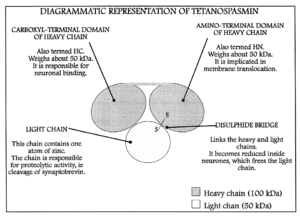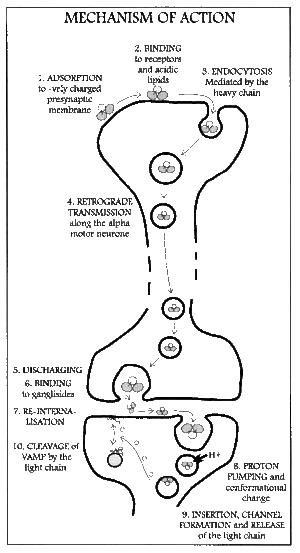Tetanospasmin facts for kids
Tetanospasmin is a very strong poison made by a tiny germ called Clostridium tetani. This germ lives in places with no air, like soil or animal waste. When the germ's spores (which are like tiny seeds) grow in these conditions, they release tetanospasmin. This powerful poison is what causes the serious illness known as tetanus. It is also sometimes called tetanus toxin or TeNT for short.
Contents
What is Tetanospasmin?
Tetanospasmin is a special type of poison that attacks the nervous system. It is one of the most powerful poisons known! It is made by a specific kind of bacteria called Clostridium tetani. These bacteria are found all over the world, often in soil, dust, and the waste of animals like horses and sheep.
How the Germ Makes the Poison
The Clostridium tetani bacteria can form tiny, tough structures called spores. These spores are like protective shells that help the bacteria survive in harsh conditions for a long time. When these spores get into a wound that doesn't have much air (like a deep cut or a puncture from a rusty nail), they can wake up and start to grow. As they grow, they produce tetanospasmin.
Why No Air is Important
The bacteria that make tetanospasmin, Clostridium tetani, are called "anaerobic." This means they can only grow and make their poison in places where there is little or no oxygen. This is why deep wounds, where oxygen can't easily reach, are more dangerous for tetanus.
How Tetanospasmin Affects the Body
Once tetanospasmin is made in a wound, it travels through the body to the spinal cord and brain. It then stops certain signals in the nervous system that control muscles.
Muscle Spasms and Stiffness
Normally, your muscles work by tightening and relaxing. When you want to move, some muscles tighten, and others relax. Tetanospasmin stops the signals that tell muscles to relax. This means muscles can only tighten, leading to painful and uncontrolled muscle spasms. This is why tetanus is sometimes called "lockjaw," because the jaw muscles can become so stiff that a person cannot open their mouth.
What Tetanus Looks Like
The muscle spasms caused by tetanospasmin can affect many parts of the body. Besides lockjaw, people with tetanus can have stiffness in their neck, difficulty swallowing, and painful body spasms. These spasms can be very strong and can even make the body arch backward.
Preventing Tetanus
Luckily, tetanus is mostly preventable thanks to vaccines. A vaccine helps your body learn to fight off the poison before it can cause harm.
The Tetanus Vaccine
The tetanus vaccine is usually given as part of a combination shot, like the DTaP vaccine (which protects against diphtheria, tetanus, and pertussis). These vaccines teach your immune system to recognize and destroy tetanospasmin. Getting vaccinated is the best way to stay safe from this serious illness.
When to Get Vaccinated
Children usually get several doses of the tetanus vaccine when they are young. Booster shots are also recommended every 10 years for adults to keep their protection strong. If someone gets a deep or dirty wound and hasn't had a recent tetanus shot, doctors might give them another dose to be safe.
History of Tetanus Discovery
The illness tetanus has been known for a very long time. Ancient doctors described people with symptoms that sound like tetanus.
Identifying the Cause
In 1884, a scientist named Arthur Nicolaier first found the Clostridium tetani bacteria in animals. Later, in 1890, two other scientists, Shibasaburo Kitasato and Emil von Behring, showed that the bacteria produced a toxin (poison) that caused the disease. They also developed a way to make animals immune to the toxin, which led to the development of the tetanus vaccine.
Impact on Health
Before vaccines, tetanus was a much more common and deadly disease. Thanks to the understanding of tetanospasmin and the development of vaccines, tetanus is now rare in many parts of the world where vaccination rates are high.
See also
 In Spanish: Tetanoespasmina para niños
In Spanish: Tetanoespasmina para niños



